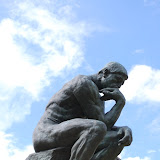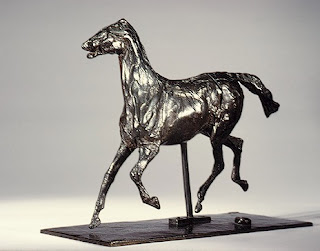
The building itself was originally a train station, and it looked it both outside and within. The inside in particular had the high, rounded ceilings of a hangar, with a large clock on one wall.
ABOVE: Inside the Musée d'Orsay
We weren’t allowed to take photos inside, which was a bummer, but we assure you there were wonderful works on display. Personally, I’ve never seen so many works by Monet, Renoir, and Van Gogh in one place.
Highlights for us included seeing some of Monet’s Water Lilies, Van Gogh’s Starry Night Over the Rhone, and Degas’ horse paintings and sculptures. We were familiar with his impressive “Dancer Series” of ballerinas, but didn’t know how skilled he was at rendering equine subjects to canvas. Degas was also an accomplished sculptor.
After ogling the many and varied works at the Orsay, we walked over the river in search of a quick lunch near the Musée de l’Orangerie. This small musem is located at the Place de la Concorde, where the famous Obelisk of Luxor stands tall in the middle of the plaza.

This obelisk was a gift to France from some Egyptian dude, and marks the opposite end of the Champs-Élysées from the Arc de Triomph. It’s from the Luxor temple in Egypt, is covered in hieroglyphics, and is topped with a gold-leafed pyramid-shaped cap.

We found a street vendor and purchased our first European hot dog, which was covered with melted cheese and Dijonaise. We devoured the dog while overlooking the Obelisk, the Champs, and the Eiffel Tower in the distance, then made our way up to the Musée de l’Orangerie.

The Orangerie is a much smaller gallery compared to the Louvre and Orsay, but it is still quite well known. Why? Oh, some nobody painter named Claude Monet bedecked entire rooms of the Orangerie with his Water Lily murals.

The upper floor of the museum, devoted solely to these eight Water Lilies murals, was seriously cool. Known as the Nymphéas, these murals are divided among two oval-shaped rooms. Upon entering, visitors are guided to benches in the center of the room so as to best view each mural--one per “side” of the room.

In the bottom floor of the gallery, we found some other great Impressionist works, by Cézanne, Matisse, Picasso, Renoir, and others.
Of the lesser-known names in the gallery, Annie really found Chaim Southine interesting. We hadn’t quite seen portraits as…skewed as his.

ABOVE: Weird portrait, unless people were just shaped different back then.
After the Orangerie, we walked BACK across the river, seeking out the Rodin Museum. I’ve had a soft spot for Auguste Rodin ever since my uncle took my sister and me on a trip to Philadelphia and introduced me to the sculptor’s work. Everyone of course knows “The Thinker,” but Rodin’s other works are equally impressive.

ABOVE: The Thinker is just above our unthinking heads.
The museum was housed in Rodin’s old Paris home, and contained a large walled sculpture garden with reproductions of many known works: The Thinker, a Balzac tribute, The Shade (inspired by Dante), and The Gates of Hell (also inspired by Dante).

ABOVE: The Gates of Hell
Inside the museum, we found various plaster and bronze castings of other famous works. Annie has always been attracted, artistically, to well-portrayed hands, and Rodin’s Cathedral is an excellent example of rendered hands.

ABOVE: "Cathedral"
One feature we both appreciated in the museum was a display case that explained the time-consuming and intricate process of casting a sculpture in bronze. Believe us: it is FAR from a simple two- or three-step process. Very interesting.
After departing the museum, we descended into the metro and bought tickets before learning there wasn’t a train running from our stop to our destination: Île de la Cité. We were directed back up to a nearby bus station, which arrived late and deposited us several blocks from the island.
We walked across the nearest bridge to the Cathédrale Notre Dame de Paris. The lines were tremendously long, but as we stood gaping we noticed that the line entering the cathedral was moving quickly.

We hopped in the back of the line, and found ourselves entering the old Gothic cathedral in just under ten minutes. We quickly learned why: the huge interior had little sense of preserved decorum, with hundreds of tourists milling about the sides and back of the sanctuary. A cacophony of voices nearly drowned out the chanting from the altar area, and flashbulbs popped everywhere despite the “No Flash” rules.

Aside from this tourist madness, the church’s interior was quite impressive. The large stained glass windows were beautiful, and the church’s side chapels and gothic architecture were inspiring.

We completed a self-tour of the interior in maybe fifteen minutes, then made our exit. Our intention was to try reaching the upper towers of the cathedral, where the famous gargoyles can be seen, but the line was nearly two hours long.
Instead, we ate dinner at a nearby restaurant called The Quasimodo (a la Victor Hugo’s The Hunchback of Notre Dame). Annie ordered her reliable spaghetti Bolognese, and I had turkey and green beans. We washed it all down with a carafe of white wine, then returned to Notre Dame in hopes of a shorter line. No dice: the line was still at least an hour long, and we didn’t feel like waiting.
We hopped on the nearest metro, and wandered home feeling fully satisfied in mind and stomach.
Paris July 23 Album:
 |
| Paris: July 23, 2011 |
Location:Paris, France



No comments:
Post a Comment